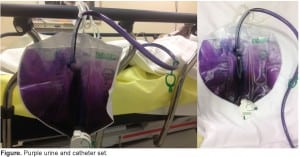| Author | Affiliation |
|---|---|
| Pauline E. Meekins, MD | Medical University of South Carolina, Division of Emergency Medicine, Charleston, South Carolina |
| Amy C. Ramsay, MD | Medical University of South Carolina, Division of Emergency Medicine, Charleston, South Carolina |
| Michael P. Ramsay, MD, JD | Medical University of South Carolina, Division of Emergency Medicine, Charleston, South Carolina |
A 67-year-old woman presented to the emergency department in congestive heart failure. She also had a history of transverse myelitis, which had caused her to be bedbound with an indwelling urinary catheter. During the physical examination, the urine in her Foley tubing and bag were noted to be bright purple. When asked, she replied that the urine had turned purple several weeks earlier. She denied suprapubic pain, but did complain of terrible constipation. Her urinalysis was significant only for a pH of 9, many bacteria, and 4 RBC/hpf. Her urine culture later grew >100,000 organisms/mLMorganella morganii and >100,000 organisms/mL Proteus mirabilis.
Purple Urine Bag Syndrome (PUBS) is an uncommon syndrome that occurs predominately in constipated bedbound women with chronic indwelling Foley catheters in which both the urine and catheter set become purple.1 The cause of this color change is still not completely known, but is thought to arise from a complex series of chemical interactions resulting from concurrent constipation and urinary tract infection (UTI).2,3
Constipation allows adequate time for gut flora to deaminate dietary tryptophan to indole. Indole then travels via the portal system to the liver, where it is conjugated to indoxyl sulfate. This is subsequently excreted into the urine, where bacterial indoxyl sulfatases catalyze it to indoxyl. This metabolite then oxidizes to both indigo (blue) and indirubin (red) in the presence of a high urinary pH.1,2 These pigments interact with the plastic of the catheter set to create a purple hue.4
Common causative bacteria are Proteus mirabilis, Pseudomonas aeruginosa, Klebsiella pneumoniae, Escherichia coli, Morganella, and Enterobacter spp.1,4 While overall a benign condition, PUBS should signal to the clinician the presence of an underlying UTI that should be treated to prevent serious complications.1,5 This includes antibiotic administration and improving Foley catheter care and hygiene.1,2

Purple urine and catheter set.
Footnotes
Supervising Section Editor: Sean O. Henderson, MD
Submission history: Submitted March 12, 2012; Accepted March 26, 2012
Full text available through open access at http://escholarship.org/uc/uciem_westjem
DOI: 10.5811/westjem.2012.3.12119
Address for Correspondence: Amy C. Ramsay, MD, Emergency Medicine, Medical University of South Carolina, 169 Ashley Avenue, MSC 300 Room 294, Charleston, SC 29425
Email: ramsayac@musc.edu
Conflicts of Interest: By the WestJEM article submission agreement, all authors are required to disclose all affiliations, funding sources, and financial or management relationships that could be perceived as potential sources of bias. The authors disclosed none.
REFERENCES
1. Khan F, Chaudhry M, Qureshi N, et al. Purple Urine Bag Syndrome: An Alarming Hue? A Brief Review of the Literature. International Journal of Nephrology. 2011. 2011:Article ID 419213, 3 pages.
2. Kang K, Jeong K, Baik S, et al. Purple Urine Bag Syndrome: case report and literature review. Clinical Nephrology. 2011;75:557–559. [PubMed]
3. Vallejo-Manzur F, Mireles-Cabodevila E, Varon J. Purple urine bag syndrome. The American Journal of Emergency Medicine. 2005;23:521–524. [PubMed]
4. Al-Sardar H, Haroon D. Purple Urine Bag Syndrome. The American Journal of Medicine. 2009;122:e1–e2. [PubMed]
5. Peters P, Merlo J, Beech N, et al. The purple urine bag syndrome: a visually striking side effect of a highly alkaline urine. Canadian Urological Association. 2011;5:233–234.


